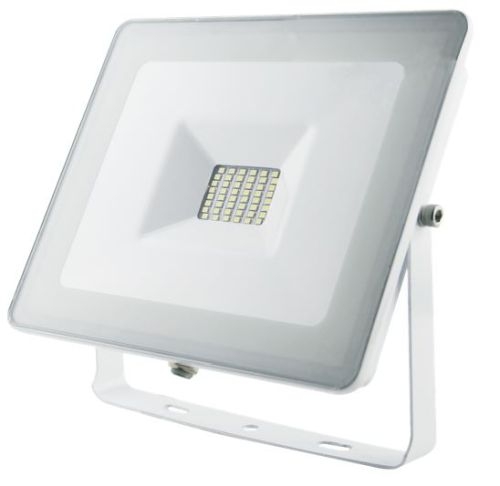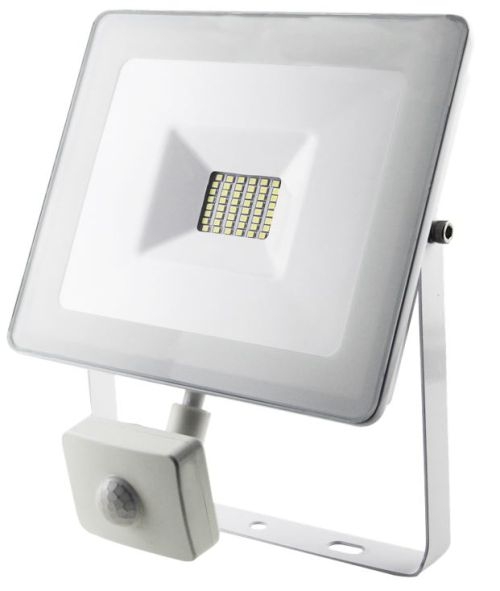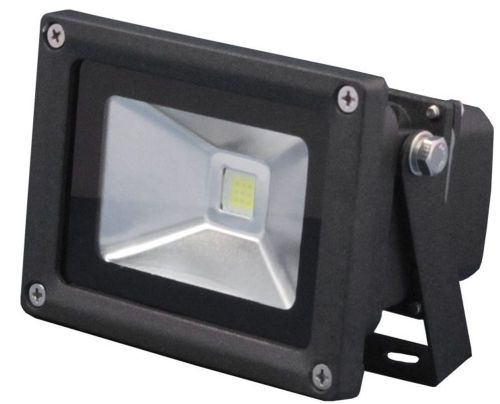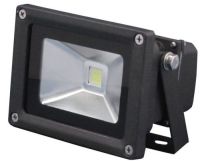Halogen lighting systems are very often used for commercial and advertising purposes. However, LED floodlights are an attractive alternative to this solution - what do they characterize and how to match their power to specific needs?
I am talking about quite significantly built-in devices, equipped with LEDs that generate a lot of light. This makes them ideal for lighting large industrial rooms as well as workshops or even advertising space.

Most importantly, however, LED floodlights are characterized by very low energy consumption, much lower than in the case of traditional incandescent bulbs and even the aforementioned halogens. Another important feature is their lifetime, which for the best models is counted even tens of thousands of hours! However, this is not all, because the floodlights are also very durable, resistant to all kinds of harmful factors, and there are several varieties on the market.
What to look for when choosing?
Of course, the usefulness of these devices largely depends on the demand. Based on the specifics of the space to be illuminated, we select a specific floodlight model. A thorough analysis of its most important parameters will help us, of course.
-Power. Undoubtedly the most important element of the floodlight specification. It should be emphasized that the power indicates the amount of current consumed by the device, which in turn translates into the brightness of the generated light, represented by the amount of lumens. This should be remembered because some sellers, using the ignorance of consumers, artificially overstate the power of the floodlights they propose.
So to determine the power of the equipment, you need to check how strong the light emits. The record of this parameter looks like this: 60 lm / W. What does it mean? That with one Watt of power, the floodlight is able to generate 60 lumens. So if we buy 35W equipment, the light will be emitted with a brightness of 2,100 lumens (35 * 60). To compare such a lamp with a halogen one should divide the result of 2100 lm by 10 - it will be the equivalent of a 210W halogen device.
It seems to be complicated, so in the rest of the text we will suggest how to choose power LED floodlights for specific tasks.
-Lightness class. Contrary to appearances, this is an important parameter, because it determines whether the LED floodlight purchased by us can be used outdoors. The tightness classes are determined based on the IP (International Protection Rating) standard, indicating the degree of protection of devices.
If you are looking for equipment that will be able to work in changing weather conditions, aim for models with an IP65 degree - it means protection against water jets poured from any direction and against the effects of dust.
- Light color. In this case, we have 3 choices. Floodlights emitting warm white, cold white and neutral are available on the market. The first type generates a slightly reduced amount of light, so it is used for decorative purposes, for example, to highlight the facade of buildings.
The cold color is associated with a very large amount of light, therefore it will be useful to illuminate dark places - driveways, billboards or industrial halls. On the other hand, when it comes to neutral color, it is the closest to neutral, therefore it will work in almost any conditions.
-A motion sensor. On the market you can find devices that constantly emit light of a certain power, as well as models with a built-in motion sensor. The first of them will prove useful wherever we need a constant light source - for example, in industrial buildings, advertising materials or in the workshop.

Floodlights with motion sensors will only be activated if a moving object crosses an infrared beam. This solution works very well around the house - it informs us that someone has approached our property. When buying a LED floodlight with a motion sensor, we should check whether it has adjustment mechanisms that allow you to adjust, among others, the sensitivity of the sensor and the exposure time.
Dimensions. This parameter is important for assembly reasons. Not everywhere we will be able to install large, fully enclosed devices.
What LED floodlight power should you choose?
As announced, we will now try to choose the power of the floodlights and the amount of light they generate for specific applications. This will allow you to better understand what equipment you should buy to enjoy the full comfort of use.
- Outdoor floodlight - in this case, a lot depends on how many places you want to illuminate. If you care about one floodlight situated, for example, above the entrance door, you should opt for models with a power of at least 30W, whose total amount of lumens will be in the range from 1500 to 2000 (at least 50 lm / W). They should emit a neutral or cold light color.
However, if we want to mount several lamps, because we have a large yard, we can put on floodlights with a power 20W, generating at least 1000 lumens. Purchasing models with a motion sensor may also be a good solution. In this way, we will significantly extend the life of the lamps.
- Garage floodlight - often it is a place where we do DIY or car repairs. In this situation, we need two strong lamps, mounted on two sides. Their power should reach at least 30W, and the intensity of emitted light a minimum of 1500 lumens.
These values can be divided by half if the garage is only used to store the car in it.
- floodlight in front of the garage - However, before the car is in the garage, we must find it somehow. The floodlights will be helpful in the evening. 20W (1000-1200 lumens) devices will be enough.
- Parking floodlight - guarded parking lots are usually large spaces for which we need really strong lamps. All this means that you should opt for 50W models - they usually generate luminous flux of more than 3000 lumens. Of course, it must be a cold light color.
- floodlight for advertising - the advertising space must be illuminated from all sides so that the marketing message is noticeable. Therefore, it is worth installing 4 or 6 floodlights with a power of at least 20 W (1000 - 1200 lumens).
- floodlight for workstation - another place that must be accurately illuminated. Lamps are best mounted directly above it - one floodlight with 30W (1000-1500 lumens) for one stand should be enough.
- Workshop floodlight - as practice shows, for one square meter of such space you need about 3-4W of floodlight power. All this means that for an area of 40 m2, it is worth buying four floodlights with a capacity of at least 30W. Of course, if there are more positions, we can buy more lamps. The light they generate should be cold or neutral, and its intensity must oscillate around the limit of 1500 lumens.
- Facade floodlight - as we have already mentioned, in this case aesthetics is important. An attractive effect can be obtained by installing slim lamps at equal intervals, with a power of 10 W (500-700 lumens) and a warm light color.

As you can see, the choice of a floodlight is associated with the need to analyze many issues, which, however, become clear when we know exactly what tasks we need a lamp for. We pay attention primarily to the power of the device, the amount of lumens and the color of the generated light. These three parameters have the greatest impact on the efficiency and usefulness of floodlights.
See the LED floodlights
Consent to publication // gulson
I am talking about quite significantly built-in devices, equipped with LEDs that generate a lot of light. This makes them ideal for lighting large industrial rooms as well as workshops or even advertising space.

Most importantly, however, LED floodlights are characterized by very low energy consumption, much lower than in the case of traditional incandescent bulbs and even the aforementioned halogens. Another important feature is their lifetime, which for the best models is counted even tens of thousands of hours! However, this is not all, because the floodlights are also very durable, resistant to all kinds of harmful factors, and there are several varieties on the market.
What to look for when choosing?
Of course, the usefulness of these devices largely depends on the demand. Based on the specifics of the space to be illuminated, we select a specific floodlight model. A thorough analysis of its most important parameters will help us, of course.
-Power. Undoubtedly the most important element of the floodlight specification. It should be emphasized that the power indicates the amount of current consumed by the device, which in turn translates into the brightness of the generated light, represented by the amount of lumens. This should be remembered because some sellers, using the ignorance of consumers, artificially overstate the power of the floodlights they propose.
So to determine the power of the equipment, you need to check how strong the light emits. The record of this parameter looks like this: 60 lm / W. What does it mean? That with one Watt of power, the floodlight is able to generate 60 lumens. So if we buy 35W equipment, the light will be emitted with a brightness of 2,100 lumens (35 * 60). To compare such a lamp with a halogen one should divide the result of 2100 lm by 10 - it will be the equivalent of a 210W halogen device.
It seems to be complicated, so in the rest of the text we will suggest how to choose power LED floodlights for specific tasks.
-Lightness class. Contrary to appearances, this is an important parameter, because it determines whether the LED floodlight purchased by us can be used outdoors. The tightness classes are determined based on the IP (International Protection Rating) standard, indicating the degree of protection of devices.
If you are looking for equipment that will be able to work in changing weather conditions, aim for models with an IP65 degree - it means protection against water jets poured from any direction and against the effects of dust.
- Light color. In this case, we have 3 choices. Floodlights emitting warm white, cold white and neutral are available on the market. The first type generates a slightly reduced amount of light, so it is used for decorative purposes, for example, to highlight the facade of buildings.
The cold color is associated with a very large amount of light, therefore it will be useful to illuminate dark places - driveways, billboards or industrial halls. On the other hand, when it comes to neutral color, it is the closest to neutral, therefore it will work in almost any conditions.
-A motion sensor. On the market you can find devices that constantly emit light of a certain power, as well as models with a built-in motion sensor. The first of them will prove useful wherever we need a constant light source - for example, in industrial buildings, advertising materials or in the workshop.

Floodlights with motion sensors will only be activated if a moving object crosses an infrared beam. This solution works very well around the house - it informs us that someone has approached our property. When buying a LED floodlight with a motion sensor, we should check whether it has adjustment mechanisms that allow you to adjust, among others, the sensitivity of the sensor and the exposure time.
Dimensions. This parameter is important for assembly reasons. Not everywhere we will be able to install large, fully enclosed devices.
What LED floodlight power should you choose?
As announced, we will now try to choose the power of the floodlights and the amount of light they generate for specific applications. This will allow you to better understand what equipment you should buy to enjoy the full comfort of use.
- Outdoor floodlight - in this case, a lot depends on how many places you want to illuminate. If you care about one floodlight situated, for example, above the entrance door, you should opt for models with a power of at least 30W, whose total amount of lumens will be in the range from 1500 to 2000 (at least 50 lm / W). They should emit a neutral or cold light color.
However, if we want to mount several lamps, because we have a large yard, we can put on floodlights with a power 20W, generating at least 1000 lumens. Purchasing models with a motion sensor may also be a good solution. In this way, we will significantly extend the life of the lamps.
- Garage floodlight - often it is a place where we do DIY or car repairs. In this situation, we need two strong lamps, mounted on two sides. Their power should reach at least 30W, and the intensity of emitted light a minimum of 1500 lumens.
These values can be divided by half if the garage is only used to store the car in it.
- floodlight in front of the garage - However, before the car is in the garage, we must find it somehow. The floodlights will be helpful in the evening. 20W (1000-1200 lumens) devices will be enough.
- Parking floodlight - guarded parking lots are usually large spaces for which we need really strong lamps. All this means that you should opt for 50W models - they usually generate luminous flux of more than 3000 lumens. Of course, it must be a cold light color.
- floodlight for advertising - the advertising space must be illuminated from all sides so that the marketing message is noticeable. Therefore, it is worth installing 4 or 6 floodlights with a power of at least 20 W (1000 - 1200 lumens).
- floodlight for workstation - another place that must be accurately illuminated. Lamps are best mounted directly above it - one floodlight with 30W (1000-1500 lumens) for one stand should be enough.
- Workshop floodlight - as practice shows, for one square meter of such space you need about 3-4W of floodlight power. All this means that for an area of 40 m2, it is worth buying four floodlights with a capacity of at least 30W. Of course, if there are more positions, we can buy more lamps. The light they generate should be cold or neutral, and its intensity must oscillate around the limit of 1500 lumens.
- Facade floodlight - as we have already mentioned, in this case aesthetics is important. An attractive effect can be obtained by installing slim lamps at equal intervals, with a power of 10 W (500-700 lumens) and a warm light color.

As you can see, the choice of a floodlight is associated with the need to analyze many issues, which, however, become clear when we know exactly what tasks we need a lamp for. We pay attention primarily to the power of the device, the amount of lumens and the color of the generated light. These three parameters have the greatest impact on the efficiency and usefulness of floodlights.
See the LED floodlights
Consent to publication // gulson



